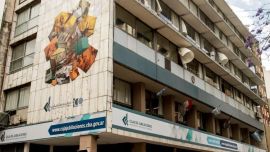A cargo plane used by military officers to fly victims over the ocean and push them to their deaths during the dark days of the 1976-1983 dictatorship was brought back to the country this week, where it may go on display at a museum detailing the horrors of the era of state terrorism.
Relatives of the dictatorship’s victims were on hand to witness the arrival of the Belfast-built Skyvan PA-51 cargo plane that landed in Buenos Aires on Saturday after a stop in Tucumán. Its identification came after sleuths traced it to the United States, where for much of the last decade it had been ferrying skydivers with few aware of its gruesome history.
An official ceremony on Monday attended by top-level government officials marked the plane's return, amid a push to exhibit it at the ex-ESMA Navy Mechanics School in Nùñez that today serves as a Museum of Memory dedicated to victims of the military regime that ruled the country from 1976 until 1983.
The plane’s most infamous journey took place on December 14, 1977. On that day, three founding members of the Madres de Plaza de Mayo human rights group – Azucena Villaflor, María Ponce de Bianco and Esther Ballestrino de Careaga – as well as two French nuns were tortured, sedated and finally forced into the small plane and flown up in the air. Their captors then threw them into the sea and to their death.
Flight records and other documentation show that a military crew did take the aircraft up on that night.
"The plane is something dark for us, but having found and identified it, we cannot allow it to continue flying," said Mabel Careaga, one of the promoters of the repatriation of the aircraft that belonged to the Naval Coast Guard.
Careaga is the daughter of Esther Ballestrino de Careaga, who was thrown into the ocean from the plane, along with other founder members of the Mothers of Plaza de Mayo, Azucena Villaflor and María Ponce de Bianco.
The trio had been members of the Madres since April 1977, and were part of a group that met regularly at a church in the City neighbourhood of San Cristóbal, organising themselves in the context of fierce illegal repression to find out what had happened to the disappeared.
"It is too horrifying to imagine my mother there," said Careaga, who together with Cecilia de Vicenti, 62, Villaflor's daughter, hopes the aircraft will be exhibited on the grounds of the Museo de Memoria Ex-ESMA, the site of a clandestine death camp where some 5,000 prisoners were held.
The initiative has the support of the government but some human rights organisations object, saying it's too gruesome and the plane should not be treated as “a show.”
"The airplane is part of the story, which is painful, but it has to be told as it was," De Vicenti said.
All the victims of that flight were singled out by a former naval officer, Alfredo Astiz, who infiltrated the Madres de Plaza de Mayo. He's now serving life in prison.
French nuns Leonie Duquet and Alice Domon were among those who lost their lives.
Searching for planes
Repatriation of the plane comes after years of efforts to track the long, multi-continental history of the plane led by relatives of the murdered Madres de Plaza de Mayo, journalists, and Argentine government officials.
A survivor of the Navy Mechanics School death camp, journalist Miriam Lewin, helped launch the campaign to comb military flight records to reveal the history of the "death flights."
The premise, she said, was "if there were 'death flights,' there had to be planes."
The group located six aircraft mentioned by former Navy officer Adolfo Scilingo, the first to admit having participated in the "death flights." In 2005, Scilingo was convicted in Spain for crimes against humanity and is serving a 30-year jail term.
Three of the aircraft were in Argentina but beyond salvage. "Of the other three, the most accessible was in Miami. Another paradoxically was in the hands of the British Armed Forces and the last was in Luxembourg," Lewin explained.

The Florida plane was the Skyvan PA-51 that operated that fateful December 14, 1977, flight. Nicknamed the "Flying Shoebox," the vessel is an all-metal twin-engine monoplane with a mid-mounted tailplane and twin rudders. In 2007, it was used to transport mail between Fort Lauderdale and the Bahamas. It was later bought by a US businessman and moved to Phoenix for skydiving flights.
The aircraft still had details of its flight and pilot history, but interpreting the logs was not easy, "There was still a pact of silence," Lewin explains.
Commercial pilot and film director Enrique Piñeyro studied them and found 10 to 15 suspicious entries. He took the records to prosecutors.
"The aircraft is a cabin without a door... six, seven metres [20 to 23 feet] long. There, they piled up all the bodies half-anaesthetised with pentothal," explained Piñeyro. "It is an appalling thing. When you look at that box, that plane, you say: 'My God, what this must have been like.'"
Investigation and evidence
The investigation into the plane’s history helped to provide evidence for a 2017 trial in which two former pilots were sentenced to life imprisonment for their role in the December 14, 1977 death flight. A third, also on trial, died shortly before a verdict was handed down.
Some 30,000 people disappeared during the era of state terrorism, according to human rights groups. The Skyvan aircraft made some 200 unexplained night-time flights between 1976 and 1978, according to Coast Guard records. There were also flights by other branches of Argentina’s armed forces.
"This is the most perverse thing. On the flights, the disappeared were disappeared completely," adds Lewin.
Military officials sought to obliterate all trace of those taken on the flights. But that December 1977 night, strong winds blew the bodies of five of the victims to the shoreline.
Forensic specialists determined they had suffered fractures corresponding to falls from a great height. The bodies were buried in a common grave south of Buenos Aires but exhumed and positively identified in 2005.
Just how many of those who went missing during the military dictatorship were killed in this manner is unknown. Many of the bodies that fell in the sea couldn’t be recovered or identified because the altitude of the plane was so high that it was equivalent to being thrown onto cement. Many of the bodies disintegrated in the sea within a few days. Others were washed up by the waters onto nearby shores.
In a 1998 television interview, formal naval officer Adolfo Scilingo gave a hint as to the regularity of the murder machine.
"Every Wednesday there was a flight and different officers were designated in rotation to take charge of them so that as many naval officers as possible were involved in those flights,” he said.
– TIMES/AFP/PERFIL























Comments